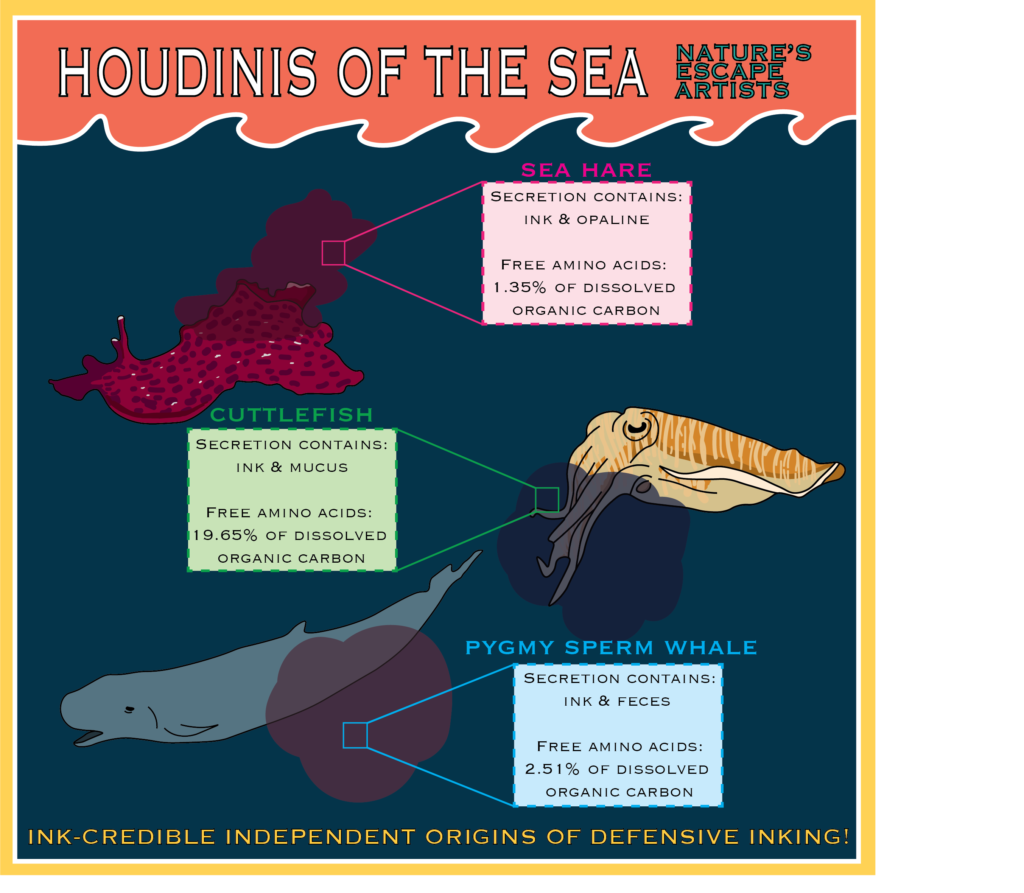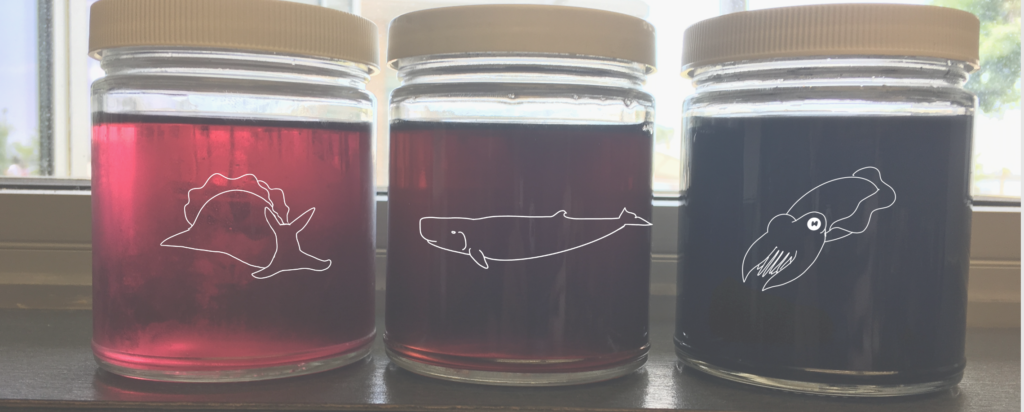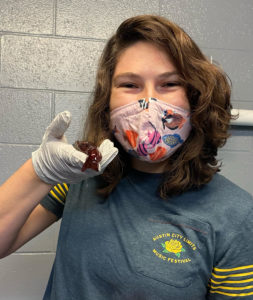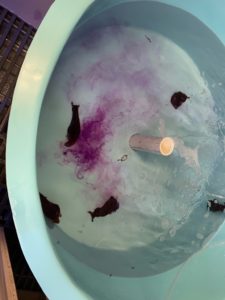
Sea hares, cuttlefishes, and pygmy sperm whales are masterful escape artists. To escape predation, they produce clouds of dark colored inks containing cocktails of sticky and biochemically unpleasant substances, a behavior called “defensive inking”. As their escape acts overwhelm the sensory systems of potential predators, the Houdinis of the sea swim to safety. How do these three distantly related organisms produce these remarkable feats of illusion and how did it evolve?
Defensive inking independently evolved in separate lineages, or convergently, in sea hares, cuttlefishes, and pygmy sperm whales. The “digestive/excretory origin” and “antimicrobial origin” are two non-mutually exclusive hypotheses suggesting that the components of ink may have evolved from digestive/excretory systems or antimicrobial compounds in other tissues, respectively. Support for the “antimicrobial origin” hypothesis includes the identification of antimicrobial molecules from the inks of sea hares and cephalopods. Additionally, sea hares’ ink contains molecules from their diet and pygmy sperm whales expel their ink from their colon, thereby supporting the “digestive/excretory origin” hypothesis.
The composition of inks are diverse and may be composed of various bio-molecules such as melanin, free amino acids, and opaline, a sticky substance from the opaline glands of sea hares . How chemically similar are the inks of sea hares, cuttlefishes, and pygmy sperm whales, and how did ink evolve in each of these separate origins? Although the chemistry and evolution of inking have been investigated in cephalopods and sea hares, research on the ink of pygmy sperm whales has been clouded by their rarity.

To tackle these questions, Dr. Lauren Eve Simonitis, an aquatic sensory biologist who recently completed her PhD in the Marine Biology Graduate Interdisciplinary Program at the Texas A&M University at Galveston, characterized the chemical composition of inks and tested their effects on predator behavior and physiology. Specifically, she used this integrative and comparative approach to unveil the function, chemistry, and evolution of inks in the California sea hare Aplysia californica, the cuttlefish Sepia officinalis, and the elusive pygmy sperm whale Kogia breviceps. During SICB 2021, Lauren presented her research on the comparative chemistry of these three inks.

To perform this research, Lauren and her collaborators collected ink samples from the ink secretions of sea hares, the ink sac of cuttlefish, and the colon of a pygmy sperm whale. They developed a new protocol for extracting and preparing the inks for chemical profiling via liquid chromatography, an analytical technique that loads samples onto a column and uses a system of solvents to separate the complex chemical cocktail based on the polarity of each molecule. Bryan Gahn, the lead chemist, recalled the challenges of working with these sticky inks, which clogged the liquid chromatography columns in just a few uses.
Many columns later, Lauren and her collaborators quantified the free amino acids found in each ink and discovered that the most abundant amino acids varied between each ink. However, they found that the inks of cuttlefish and pygmy sperm whales, which are both melanin-based inks, had some overlap in the most abundant amino acids. Interestingly, all three inks contained D-amino acids, which are usually found in bacterial cell walls. As bacteria are found in the digestive system and D-amino acids are linked to antimicrobial activity, these findings garner support for both the “digestive/excretory” and “antimicrobial” hypotheses.

In addition to observing differences in the amount of each amino acid, Lauren and her collaborators found differences in the ratio of free amino acids to dissolved organic carbon across all three inks, thereby suggesting that each ink is a unique cocktail of organic molecules. Surprisingly, while their analyses did not identify dopamine and L-DOPA, two molecules previously found in squid ink, Lauren et al. found unknown compounds in all three inks, which may have been previously mistaken for dopamine and L-DOPA. Because these unknown compounds eluted at similar times during chromatography, Lauren and Bryan suggest that these molecules might be dopamine or L-DOPA attached to another molecule, or other molecules similar in polarity or size.
What are these unknown molecules and are they shared across all three inks? In addition to identifying these unknown molecules and identifying the chemical basis of convergent inks, Lauren is combining this research with comparative physiology methods to explore how the chemical differences in these inks affect the physiology of potential predators. By integrating chemistry, behavior, physiology, and evolutionary biology to investigate the independent origins of defensive inks, Lauren et al. are unveiling secrets from the Houdinis of the sea.
About the author:

Emily is a PhD student in the department of Ecology, Evolution, and Marine Biology at the University of California, Santa Barbara. She studies the molecular evolution of bioluminescence and aims to use this research to develop new biotechnologies.
Emily’s website: https://emlau.weebly.com/
Emily’s email: emily.lau@lifesci.ucsb.edu

